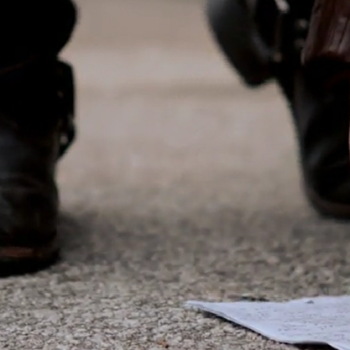
On this Maundy Thursday, when Christ instituted the Sacrament of His Body and Blood, it’s good to reflect on the significance of that gift. Different theologies, of course, think of Holy Communion differently, but there would surely be a consensus that the sacraments work against the assumption that all we need is “spirituality,” which involves repudiating and escaping the material world.
Christianity, unlike Eastern religions, has a high view of the material realm, with its doctrines of creation, incarnation, atonement, and resurrection, as well as its use of the sacraments and the Lord’s Supper. (I would also add Christianity’s understanding of vocation and the Christian life, which also affirms the spiritual significance of our earthly life.)
Luther, in particular, had a high view of the material dimensions of the Christian faith. I have always thought that Lutheran sacramental theology is “higher” than that of Roman Catholicism. Transubstantiation teaches that the bread and wine in Holy Communion become mere appearances, a docetic illusion in which the presence of Christ’s Body annihilates the created material. In contrast, the Lutheran notion of a “sacramental union” teaches that Christ’s Body and Blood are joined to the bread and wine in such a way that the supernatural and the natural come together.
Trevor Sutton and I discuss Luther’s sacramentalism and its connection to justification and creation–as well as what it discloses about the Christian life and how it counters the Gnosticism that plagues contemporary religion–in our book Authentic Christianity: How Lutheran Theology Speaks to a Postmodern World.
An excerpt from that book for Maundy Thursday:
In his writing on justification, the contemporary theologian Oswald Bayer said that when we are justified by faith, we are reconciled to God, and we are also reconciled to His creation. This is because, he says, God uses the physical world of His creation to bring to us our justification: water, bread, wine. We might add other physical elements: ink stamped on paper and bound into a book; sound waves vibrating in the air; the body of the pastor presiding in a building made of stone and steel. Says Bayer,
“The “new creation” is a return to the world, not a retreat from it. The new creation is a conversion to the world, as a conversion to the Creator, hearing God’s voice speaking to us and addressing us through his creatures. Augustine was wrong to say that his voice draws us away from God’s creatures into the inner self and then to transcendence. Counteracting Augustine’s inwardness in its withdrawal from the world, Luther emphasizes the penetrating this-worldliness of God. God wills to be the Creator by speaking to us only through his creatures.[1]
St. Augustine, for all of his greatness, remained something of a Platonist, something he would share with Zwingli and Calvin. This suggests that the rejection of the religious significance of the world in favor of the inner self and transcendence is nothing new after all. It is also the basis of Medieval asceticism. As we shall see, Luther’s sacramentalism is connected to his critique of monasticism and to his doctrine of vocation.
But we can see the effect of the Gospel as expressed in the Sacraments in Luther’s own attitude towards God’s creation. As a monk, Luther was an extreme ascetic, rejecting the world and all its ways, but when he discovered the Gospel of God’s free grace in Christ, he embraced every facet of God’s creation. Bayer discusses Luther’s “turn from radical denial of the world to an impressive affirmation of everything that is of the world and nature.”[2]
“After Luther was thoroughly convinced, because of his new understanding of Word and Sacrament, that the spiritual is constituted in the form of what was earthly—not only negatively but also positively—the spiritual importance of all things earthly was opened to him in a positive sense as well.”[3]
“The spiritual is constituted in the form of what was earthly.” That is a succinct statement of Lutheran teaching on Christ, the Sacraments, and—as we shall see—the Christian life.
[1]Oswald Bayer, Living by Faith (Grand Rapids, MI: William B. Eerdmans Publishing Company, 2003), Chapter 3.
[2]Oswald Bayer, Martin Luther’s Theology: A Contemporary Interpretation (Grand Rapids, MI: Eerdmans, 2008), p. 141.
[3]Ibid. The italics are Bayer’s.
Painting: Altarpiece, central panel, St. Mary’s Church in Wittenberg, by Lucas Cranach the Elder [Public domain] via Wikimedia Commons














